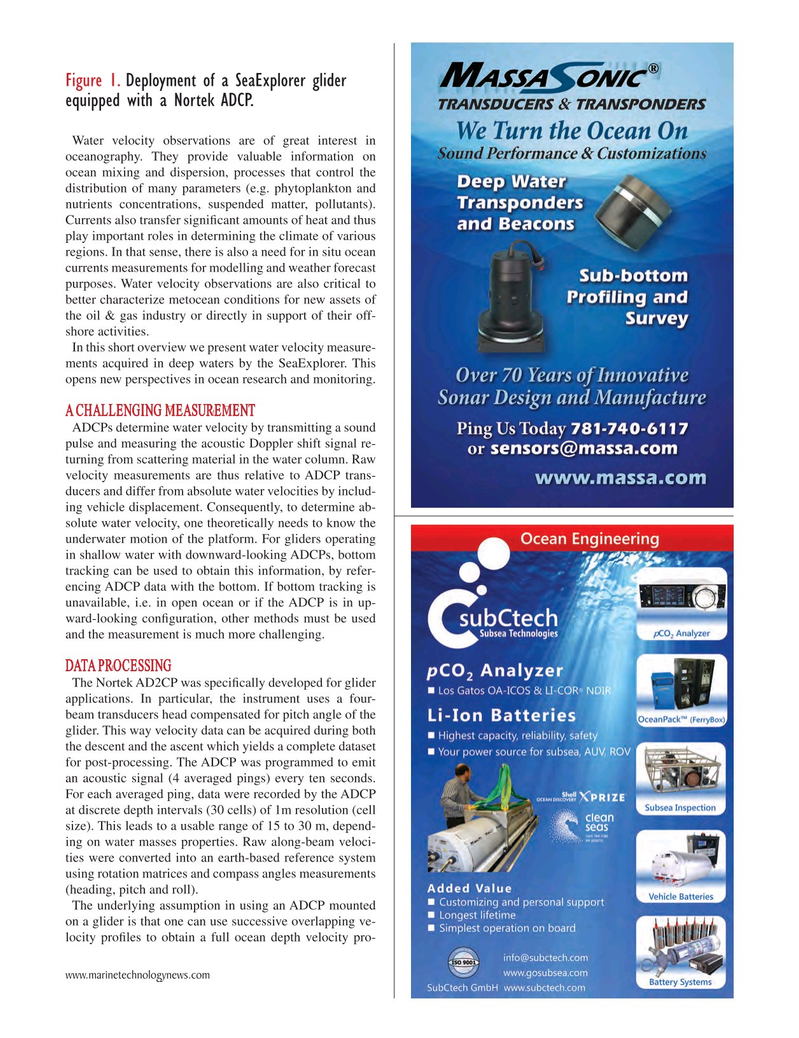
Page 43: of Marine Technology Magazine (October 2018)
Ocean Observation: Gliders, Buoys & Sub-Surface Networks
Read this page in Pdf, Flash or Html5 edition of October 2018 Marine Technology Magazine
Figure 1. Deployment of a SeaExplorer glider equipped with a Nortek ADCP.
Water velocity observations are of great interest in oceanography. They provide valuable information on ocean mixing and dispersion, processes that control the distribution of many parameters (e.g. phytoplankton and nutrients concentrations, suspended matter, pollutants).
Currents also transfer signi? cant amounts of heat and thus play important roles in determining the climate of various regions. In that sense, there is also a need for in situ ocean currents measurements for modelling and weather forecast purposes. Water velocity observations are also critical to better characterize metocean conditions for new assets of the oil & gas industry or directly in support of their off- shore activities.
In this short overview we present water velocity measure- ments acquired in deep waters by the SeaExplorer. This opens new perspectives in ocean research and monitoring.
A CHALLENGING MEASUREMENT
ADCPs determine water velocity by transmitting a sound pulse and measuring the acoustic Doppler shift signal re- turning from scattering material in the water column. Raw velocity measurements are thus relative to ADCP trans- ducers and differ from absolute water velocities by includ- ing vehicle displacement. Consequently, to determine ab- solute water velocity, one theoretically needs to know the underwater motion of the platform. For gliders operating in shallow water with downward-looking ADCPs, bottom tracking can be used to obtain this information, by refer- encing ADCP data with the bottom. If bottom tracking is unavailable, i.e. in open ocean or if the ADCP is in up- ward-looking con? guration, other methods must be used and the measurement is much more challenging.
DATA PROCESSING
The Nortek AD2CP was speci? cally developed for glider applications. In particular, the instrument uses a four- beam transducers head compensated for pitch angle of the glider. This way velocity data can be acquired during both the descent and the ascent which yields a complete dataset for post-processing. The ADCP was programmed to emit an acoustic signal (4 averaged pings) every ten seconds.
For each averaged ping, data were recorded by the ADCP at discrete depth intervals (30 cells) of 1m resolution (cell size). This leads to a usable range of 15 to 30 m, depend- ing on water masses properties. Raw along-beam veloci- ties were converted into an earth-based reference system using rotation matrices and compass angles measurements (heading, pitch and roll).
The underlying assumption in using an ADCP mounted on a glider is that one can use successive overlapping ve- locity pro? les to obtain a full ocean depth velocity pro- www.marinetechnologynews.com
MTR #8 (34-49).indd 43 MTR #8 (34-49).indd 43 9/27/2018 2:43:26 PM9/27/2018 2:43:26 PM

 42
42

 44
44
